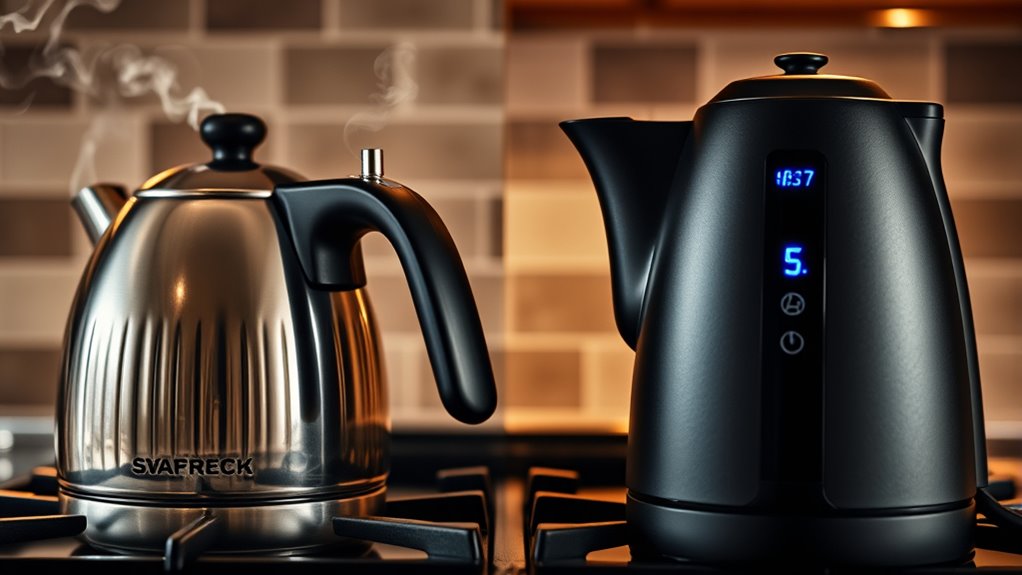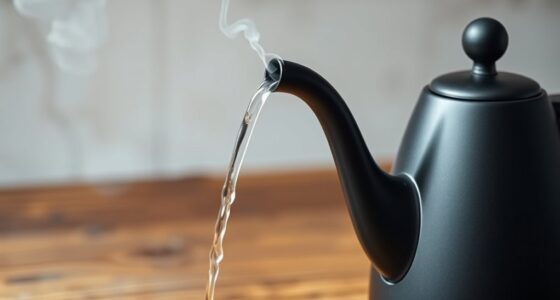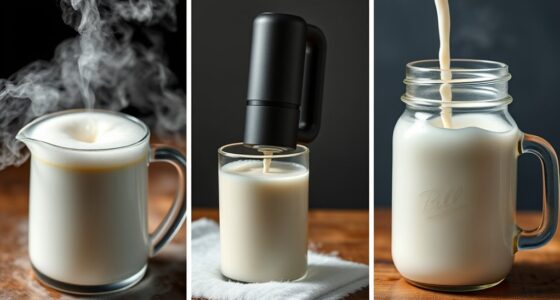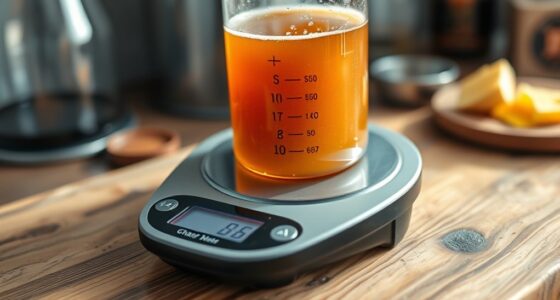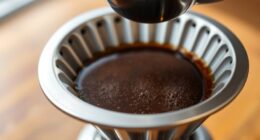If you want quick, energy-efficient boiling, electric kettles are the way to go. They heat water faster, often include handy features like variable temperature controls, and shut off automatically for safety and savings. Stovetop kettles have a classic look and can add charm, but they’re slower and may use more energy. Curious about which style suits your kitchen and lifestyle? Keep exploring to find out which kettle matches your needs best.
Key Takeaways
- Electric kettles boil water faster and more efficiently due to direct heating and automatic shut-off features.
- Stovetop kettles are slower but offer a traditional aesthetic and nostalgic experience.
- Electric models typically use less energy and include customizable temperature controls.
- Stovetop kettles often serve as decorative pieces, fitting vintage or rustic kitchen decor.
- Choice depends on priorities like speed, energy efficiency, style, and user convenience.
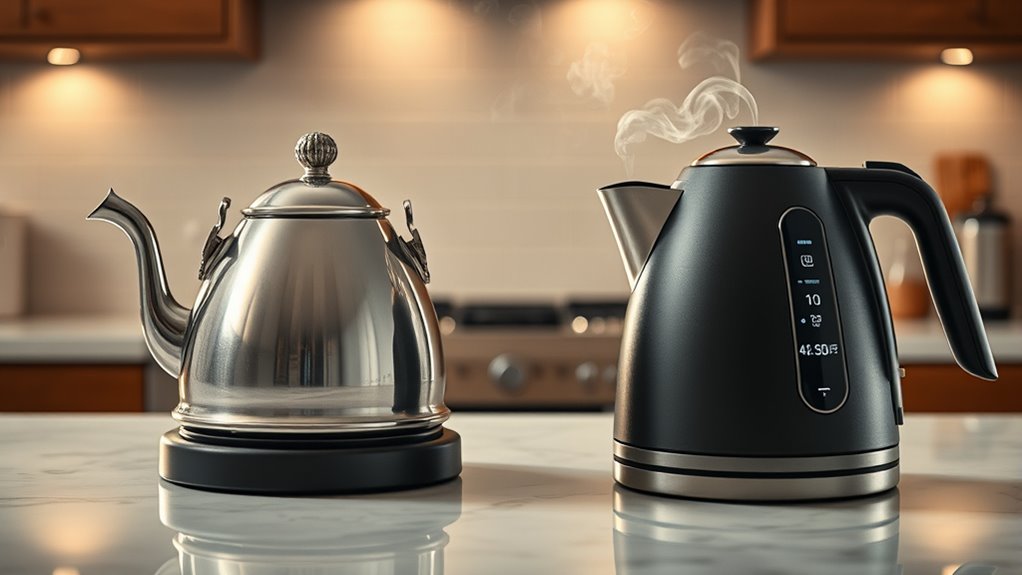
Have you ever wondered which kettle truly heats up the fastest or offers the best features? When choosing between stovetop and electric kettles, it’s essential to consider various factors like energy efficiency and aesthetic appeal, which substantially influence your everyday convenience and home style.
Electric kettles are renowned for their quick heating capabilities. They often boil water faster than stovetop models because they are designed to transfer heat efficiently directly to the water. If speed is a priority, an electric kettle is your best bet. Plus, many modern electric kettles come with features like variable temperature controls, keep-warm functions, and automatic shut-off, adding to their practicality. These features not only enhance user experience but also contribute to energy efficiency by avoiding unnecessary energy consumption once the water reaches the desired temperature. On the other hand, stovetop kettles, while slower, have a certain charm and aesthetic appeal that can complement classic or rustic kitchen designs. Their traditional look and feel add a cozy, nostalgic touch to your space, making them more than just functional items—they’re decorative pieces as well.
Electric kettles boil water faster and feature modern controls, while stovetop models add rustic charm to your kitchen decor.
Energy efficiency plays an essential role in your choice. Electric kettles typically use less energy overall because they boil water quickly and shut off automatically, preventing waste. Conversely, stovetop kettles may consume more energy since they often stay on longer and lose some heat to the surrounding environment. If you’re environmentally conscious or want to save on electricity bills, an electric kettle with precise temperature settings and fast boiling times might be more cost-effective in the long run. Additionally, the technology behind electric kettles significantly enhances their efficiency compared to traditional stovetop models. Incorporating energy-efficient design features can further reduce your environmental impact and utility costs.
Aesthetic appeal is another important aspect. Electric kettles come in a wide array of styles, colors, and finishes, allowing you to match or accentuate your kitchen decor. Sleek, minimalistic designs with digital displays appeal to modern tastes, while retro or colorful models add personality to your countertops. Stovetop kettles, however, usually feature classic metal finishes, often with a polished or matte look that complements traditional or vintage kitchens. Their timeless design can serve as a statement piece, adding character and warmth to your space.
Ultimately, your choice hinges on what you value most: if quick, energy-efficient boiling with modern features is your priority, an electric kettle is ideal. But if you prefer a traditional aesthetic that enhances a cozy kitchen atmosphere, a stovetop kettle might be the better fit. Both have their strengths, so consider your style, energy habits, and how you use your kettle daily to make the right decision.
Frequently Asked Questions
Which Kettle Type Is More Energy-Efficient?
When considering which kettle type is more energy-efficient, you should focus on their energy consumption and environmental impact. Electric kettles generally use less energy because they heat water faster and lose less heat to the surroundings. Stovetop kettles tend to consume more energy due to slower heating and heat loss. Choosing an electric kettle helps you save energy, reduces environmental impact, and makes your boiling process more eco-friendly.
How Long Does Each Kettle Type Take to Boil?
Imagine the race against time; that’s what boiling speed feels like. An electric kettle heats water swiftly, often in 3-5 minutes, thanks to rapid heating elements. Stovetop kettles take longer, usually around 6-10 minutes, depending on heat and volume. Your choice hinges on how quickly you need hot water—electrics excel in heating time, while stovetops offer a more traditional, slow burn.
Are Electric Kettles Safer Than Stovetop Kettles?
You might wonder if electric kettles are safer than stovetop ones. Electric kettles often have safety features like automatic shut-off and boil-dry protection, reducing accidents. They also offer user convenience with quick boiling and easy use. Stovetop kettles require more attention to prevent overboiling or accidents. Overall, electric kettles tend to be safer due to built-in safety features designed to protect you during use.
Can Stovetop Kettles Be Used on Induction Cooktops?
Imagine the warm comfort of a familiar routine. Stovetop kettles can be used on induction cooktops if they’re made from induction-compatible materials like cast iron or certain stainless steels. Always check for induction compatibility to avoid disappointment. Using the right cookware materials guarantees your stovetop kettle heats efficiently and safely, letting you enjoy your tea or coffee without worry. Keep an eye on the labels, and your kettle will serve you well.
What Maintenance Is Required for Each Kettle Type?
You should regularly clean and descale your kettle to keep it functioning well. For stovetop kettles, clean the exterior and rinse thoroughly after each use, and descale if you notice mineral buildup. Electric kettles need regular cleaning inside, especially if you have hard water; descaling every few months helps maintain performance. Both types benefit from occasional deep cleaning to prevent limescale and ensure safe, efficient boiling.
Conclusion
In the battle between stovetop and electric kettles, it’s clear both have their perks. Did you know electric kettles heat water nearly 50% faster? If speed matters, they’re the way to go. But if you prefer a traditional feel, stovetops offer a classic experience and often better control. Ultimately, your choice depends on your priorities—speed or nostalgia. Whichever you choose, you’ll be boiling water efficiently and comfortably, making your mornings just a bit easier.
